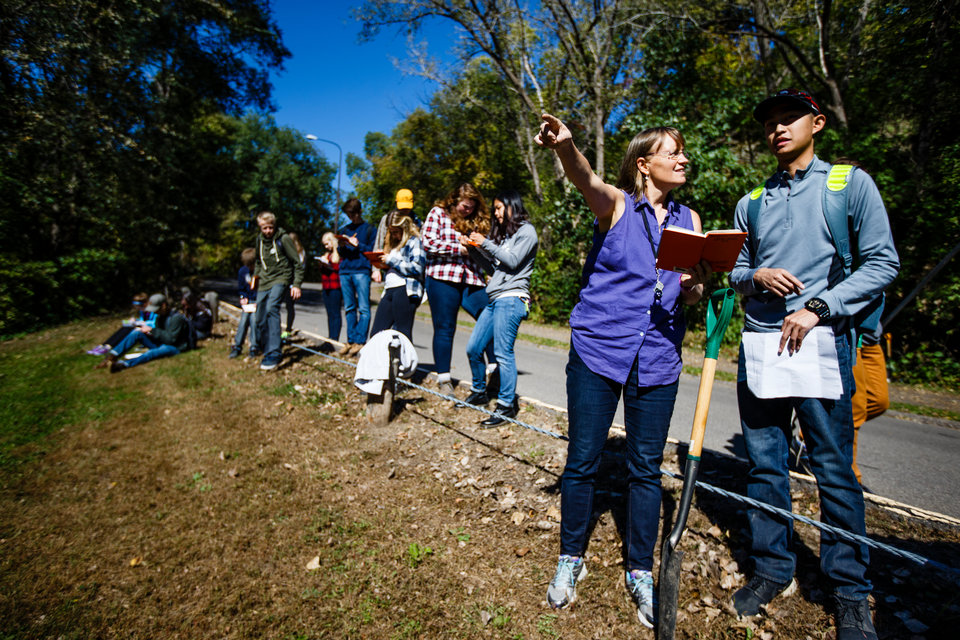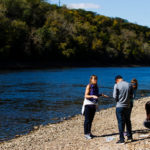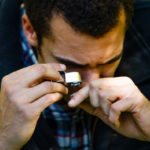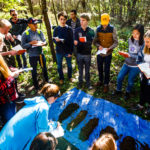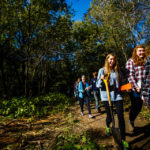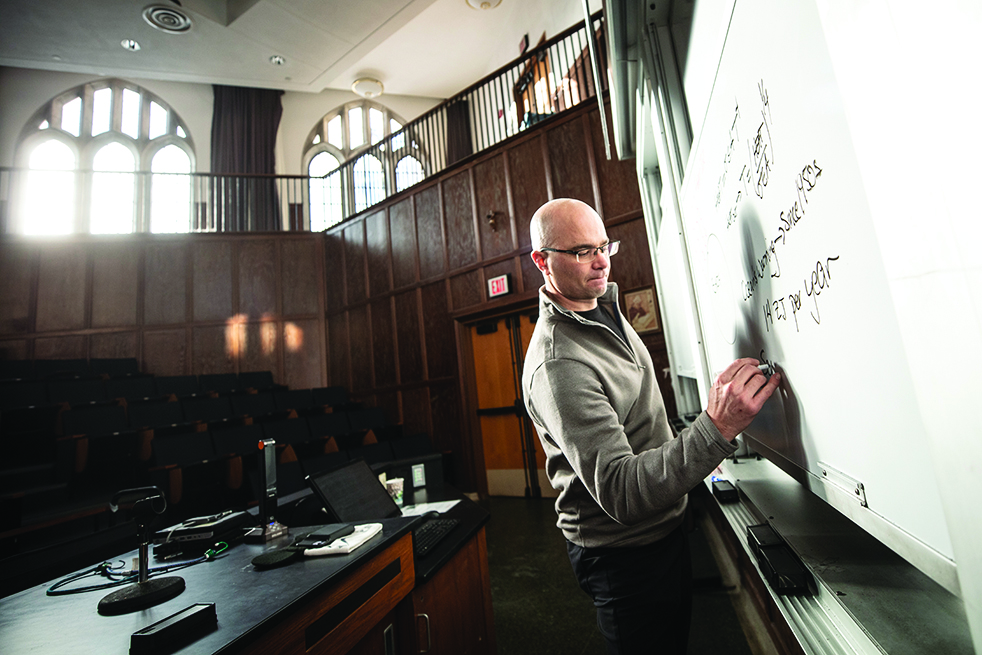Freshman Ben Linke thrusts a metal shovel into the earth along the shore of the Mississippi River. The shovel carves through rocky sand and dirt, and the ring from it echoes off the surrounding water, hills and trees of Hidden Falls Regional Park in St. Paul.
“Power through it,” freshman classmate Elliott Allen says in encouragement, as two other classmates, Emily Sweeney and Jenna Abrahamson, jot notes about the sizes, types and shapes of rocks strewn around them on the waterfront.
The sound of laughter suddenly drifts down the water and a river boat full of elementary students on a field trip floats by.
“What are you digging for?” one young boy yells.
“Sediment layers,” Allen quickly replies. Then, after a couple seconds of thought: “There’s a giant X on the ground. We’re digging for treasure!”
The boy looks behind him, perhaps for an adult to confirm that this could be true, before yelling back, “Have fun looking!” as he cruises away.
While it’s not actually treasure, Linke, Allen, Sweeney and Abrahamson do know what they’re looking for: They’re here to profile this particular section of land for professor Lisa Lamb’s Geology 115 class. Twelve of their classmates are doing the same thing in groups of four around the park, a field day helping prepare them for an upcoming midterm.
These students – who also share Environmental Studies 151 class together – are part of a bigger search at St. Thomas, one that has been formulating in theory, discussions and desire for months: How can the school help first-year students connect more effectively to the entire St. Thomas community? And how can faculty and staff help erase the divisions across curricular, co-curricular, residence and social experiences?
The potential answer is playing out all over campus. For the first time, St. Thomas has offered incoming freshmen the chance to participate in Living Learning Communities (LLCs). Five different LLCs – built around themes of sustainability; health and wellness; Aquinas Scholars; and paired courses (mathematics and computer science, and sociology and philosophy) – are available, and 79 students have enrolled. They share classes and other activities with their peers and faculty, and live together in designated residence halls. At every turn students have opportunities to connect with each other and the university as a whole.
“That’s really the exciting part: that we see these new students come to our campus and automatically have a connection,” said Mary Ann Ryan, associate vice president for student affairs. “Their education will be so rich because it extends to be part of their entire life on campus.”
A Tommie twist
LLCs are not exactly new. Ryan points out that their roots can be traced back to the origin of higher education institutions themselves, when faculty would often live in residence halls with their students, naturally blending curricular and co-curricular lines. LLCs have become far more common in different variations in recent decades though, and have a wide-ranging definition across different universities and colleges.
When Richard Plumb arrived as provost in July 2014, he wondered if St. Thomas had used LLCs in the past and, if not, what would stand in the way of launching them. He had helped lead the creation of LLCs in his previous position at Loyola Marymount University and saw firsthand how effective they were at connecting students to their school and increasing retention. He believes it can do the same at St. Thomas.
“We had a lot of conversations here and got to where we could tell faculty, ‘If you want to do this, consider it done. If you have the ideas, I’ll support it and we’ll clear any obstacles,’” Plumb said.
While there have been special interest “communities” at St. Thomas led by faculty and students in the past, that dedication from Plumb represented a new level of structure and resources to support communities in an LLC-based model. The Sustainability and Aquinas Scholars LLCs quickly fell into place as pilot candidates for this first year, and soon were followed by the two sets of paired courses, and health and wellness.
The defining characteristic of the five programs in the St. Thomas model is that each LLC’s students share a class with one another. (The health and wellness LLC course is actually for juniors and seniors, who partner with the freshman LLC participants.) Efforts were made to have as many students from each class live together as possible, but not every member of an LLC course lives in the dorms together. (For example, some members of the sustainability classes don’t live on the LLC floor with their classmates. Those who do live together in various freshman residence halls each have an LLC resident adviser.) Thanks to coordination between faculty, residence life, and both academic and student affairs, every LLC has its own approach to programming too.
Take health and wellness, for example: Beyond working with juniors and seniors on a variety of health measurements and projects, LLC participants have taken workout classes together in the Anderson Athletic and Recreation Complex; organized running groups along with their health and wellness major resident adviser, junior Francesca Karas; received a lesson on healthy shopping with professor Lesley Scibora; created a custom menu for a tailgating event; and enjoyed the social benefits of living with people who share similar passions.
“The best friends I have here are right around me, which is the best thing ever,” said freshman Jessica Thomas of the health and wellness LLC. “It’s like you’re a family here. The sense of community is amazing.”
Similar reviews have marked the opening months across all five LLCs. Students in interviews talked about the benefits of having classmates living near them and the ease that creates for getting together to study. Others have especially enjoyed getting to know their faculty on a more personal level, alleviating some of the intimidation that can come in the first semester of freshman year.
“It really incubates a tight-knit community. I feel like we’ll continue getting close,” said freshman Chris Razidlo of the sustainability LLC. “Especially with the professors, we can be on a first-name basis and just be really close with them. I feel like that really makes us feel like part of the community right away. It feels more like we’re part of a team than the whole teacher-student thing. It’s a lot less intimidating to talk to them.”
Building bridges between faculty and students was a priority from day one, when LLC students moved onto campus early on the Thursday before Labor Day. Professor Elise Amel talked with sustainability students over pizza and the homemade salad she brought to a dinner gathering on John P. Monahan Plaza. Sociology professor Meg Wilkes Karraker, took her sociology and philosophy paired-course students to Izzy’s for ice cream with philosophy professor Jonathan Stoltz.
“From the literature, we know a couple major things enhance student retention and success, and one of those things is a relationship with each other. But there has been more attention to their relationship with faculty,” Karraker said. “There’s a conversation you have when you’re standing at Izzy’s eating an ice cream cone that you don’t have when you’re standing at the front of a sociology or philosophy class. We see each other differently, have different conversations and there are deeper relationships.”
Several professors said they are more effective advisers, too, because of stronger relationships with students and having them all in class together.
“It’s definitely easier to advise them with this model, where we have them in class and I know how they’re doing on a week-to-week basis,” said mathematics associate professor Mike Axtell, who is leading a paired-course LLC cohort with computer and information sciences assistant professor Kate Lockwood. “My freshman advisees that I don’t have in class, I may not see them until midterm grades. That can be too late for students, sometimes. This should definitely improve retention. ... We don’t want students falling through the cracks.”
One university
The same emphasis on student-faculty engagement also can be found in the strategic plan’s theme of “one university,” which acknowledges the growing complexity of St. Thomas and the need for “formal and informal structures that support a system of collaboration and integrated decision-making for all units on campus.” Development of the LLCs has required a significant level of coordination and cooperation among groups across campus, turning the project into one big, ongoing example of the spirit of one university.
“This kind of collaboration speaks to the larger thrust of the university and aligning with the mission,” Scibora said. “Reaching our students and having these same goals (of the LLCs) in mind, that’s important for all (university faculty and staff).”
The biggest goal of the LLCs is to increase the number of students who want to continue to be Tommies, but there are any number of factors beyond pure retention levels that administrators are using to measure the pilot program’s effectiveness. Everyone involved will provide feedback in a variety of formats, which will be used to help the existing program evolve and new ones to start more effectively.
“We know best practices out there but we want to find out what’s best for St. Thomas,” said Ryan, who already is in talks with faculty interested in heading up new LLCs. “We will have rich data and it will only help make us better and better in years to come.”
Throughout the first semester, though, there have been plenty of conversations and anecdotal evidence to clue people into how the LLCs are going so far: Dozens of students, faculty and administrators were interviewed for this story over the course of several months, and there was unanimous belief that the LLCs are a positive step forward for St. Thomas. There will undoubtedly be elements of the program to improve and changes to make, but so far the benefits seem to far outweigh any problems the LLCs face in becoming a part of the university’s landscape.
One of those benefits was on full display late in October as a group of women from the health and wellness LLC took a spin class together in the AARC: having someone to sweat with. After assistant athletic director Megan Jacobson finished putting them through 45 minutes of mid-day miles, Thomas and freshman Sydney Mueller talked about all the reasons they feel good about being in an LLC.
“There are so many benefits to (the LLC). Looking back to when we registered and were asked if we were interested in doing the Living Learning Community ... now I am just really glad I signed up,” Mueller said. “The professors are so wonderful and people are building so many great relationships.”
Then, with a look back to Thomas and a shake of her head: “I couldn’t imagine going to school anywhere else.”
Read more from St. Thomas magazine.
